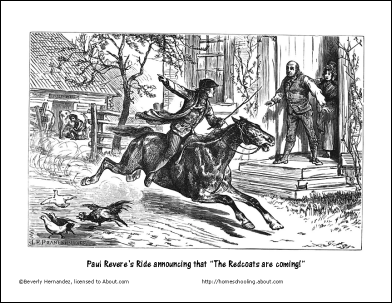Who is the most famous silversmith of all time? I’ll give you a hint: “The redcoats are coming!” Yes, the great American patriot Paul Revere was a silversmith by trade, which just goes to show how indelibly linked silver and the American patriot movement were.
Of course, Revere’s connection to silver isn’t as well known as his famous Midnight Ride – today’s “patriots” are “community organizers” and fiat-money fueled “private equity” consultants. But for those interested in America’s true heritage, the untold story of Paul Revere’s love affair with silver is one worth learning.
Early Years

Paul Revere was born in Boston in 1735. His father was a French Huguenot, who became apprenticed to a silversmith at the age of 13. Paul was his third of twelve children, and eventually the eldest surviving son. This led him to follow in his father’s footsteps and become his apprentice at age 13.
When Revere’s father died in 1754, Paul was legally too young to be the Master of his family’s silver shop. This shows that then, just as now, there was no free market in America. Guilds controlled the economy much like the government and Big Labor do now, through regulations designed to limit competition. These regulations were for the benefit of existing practitioners and to the detriment of both consumers and would-be entrants to the field.
With few other options, Revere joined the military and served during the French and Indian War. This is much like today’s “poverty draft.” Also, just as today, young citizens who are not legally old enough to drink are sent to foreign lands to die, in Revere’s day, young people who were not old enough to legally own a business were deemed old enough to fight in wars.
Paul Revere the Businessman

Revere didn’t stay in the army long, and when he returned, he assumed control of his family’s silver shop. As a silversmith, Revere met a wide variety of people, and his mingling with folks of all walks of life helped instill within him a revolutionary spirit.
Revere wasn’t just an average silversmith, either – he was a great and innovative one. He developed new technologies for the mass production of silver products, rather than focusing on high-end, customized products for the rich. In the 1700s, living standards were constantly on the rise as government control of the economy slipped, and the entrepreneurial Revere was on the forefront of serving this new and developing middle class. He mass-produced teaspoons and belt buckles, reaching wide audiences and improving the lives of everyday Americans.
Revere’s success as a businessman allowed him to support the Revolutionary cause. After the war, he continued to excel at business, and he was ahead of the curve with the Second Great Awakening – a religious revival in the U.S. – selling silver bells to the many churches that were popping up all over the country. Later, Revere diversified into the manufacturing of rolled copper products, including bolts and spikes that were used in ship construction.
Conclusion
Paul Revere is a true American hero – and not just for his Midnight Ride. He is one of America’s great and unsung entrepreneurs. And he was a silver man, through and through.



